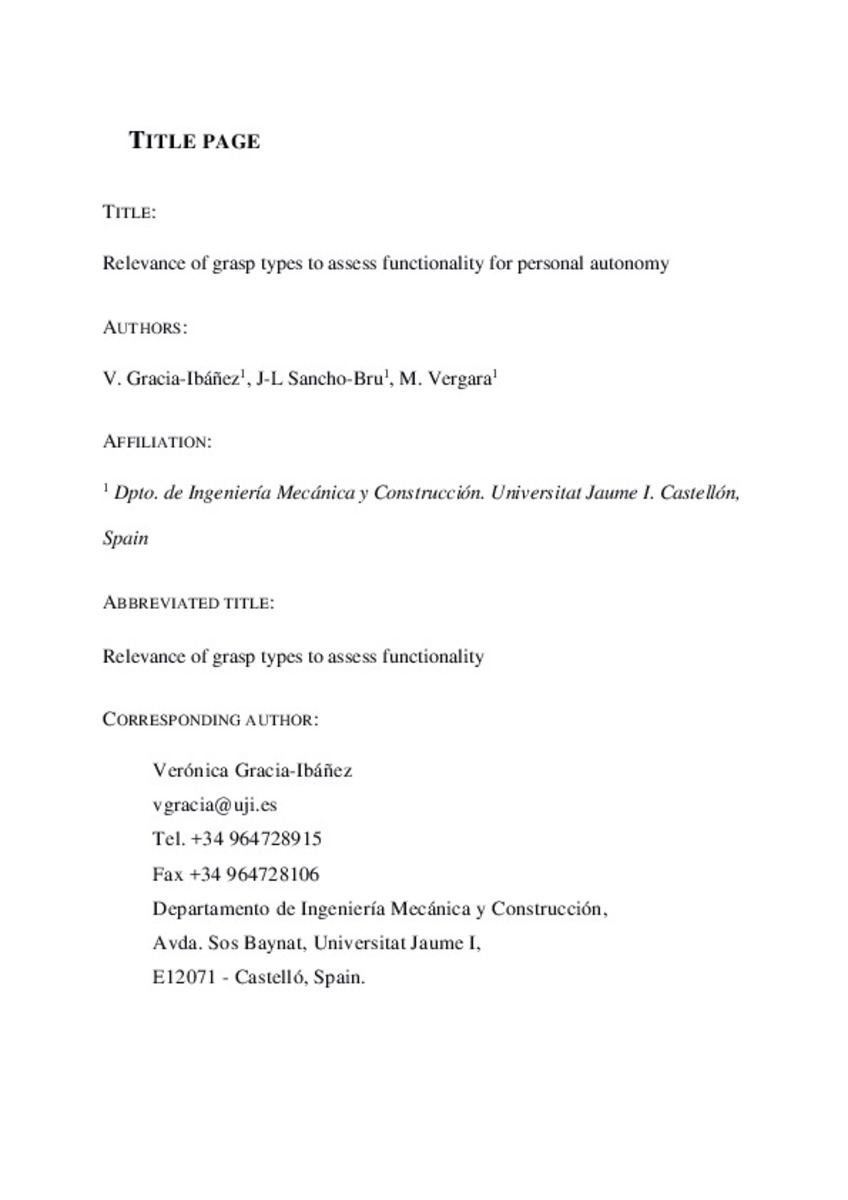Mostrar el registro sencillo del ítem
Relevance of grasp types to assess functionality for personal autonomy
| dc.contributor.author | Gracia-Ibáñez, Verónica | |
| dc.contributor.author | Sancho-Bru, Joaquin L. | |
| dc.contributor.author | Vergara, Margarita | |
| dc.date.accessioned | 2017-05-03T10:57:58Z | |
| dc.date.available | 2017-05-03T10:57:58Z | |
| dc.date.issued | 2017-03 | |
| dc.identifier.citation | GRACIA-IBÁÑEZ, Verónica; SANCHO-BRU, Joaquin L.; VERGARA, Margarita. Relevance of grasp types to assess functionality for personal autonomy. Journal of Hand Therapy, 2017. | ca_CA |
| dc.identifier.uri | http://hdl.handle.net/10234/167442 | |
| dc.description.abstract | Study Design Cross-sectional research design. Introduction Current assessment of hand function is not focused on evaluating the real abilities required for autonomy. Purpose of the Study To quantify the relevance of grasp types for autonomy to guide hand recovery and its assessment. Methods Representative tasks of the International Classification of Functioning, Disability and Health activities in which the hands are directly involved were recorded. The videos were analyzed to identify the grasps used with each hand, and their relevance for autonomy was determined by weighting time with the frequency of appearance of each activity in disability and dependency scales. Relevance is provided globally and distinguished by hand (right-left) and bimanual function. Significant differences in relevance are also checked. Results The most relevant grasps are pad-to-pad pinch (31.9%), lumbrical (15.4%), cylindrical (12%), and special pinch (7.3%) together with the nonprehensile (18.6%) use of the hand. Lumbrical grasp has higher relevance for the left hand (19.9% vs 12%) while cylindrical grasp for the right hand (15.3% vs 7.7%). Relevancies are also different depending on bimanual function. Discussion Different relative importance was obtained when considering dependency vs disability scales. Pad-to-pad pinch and nonprehensile grasp are the most relevant grasps for both hands, whereas lumbrical grasp is more relevant for the left hand and cylindrical grasp for the right one. The most significant difference in bimanual function refers to pad-to-pad pinch (more relevant for unimanual actions of the left hand and bimanual actions of the right). Conclusions The relative importance of each grasp type for autonomy and the differences observed between hand and bimanual action should be used in medical and physical decision-making. | ca_CA |
| dc.description.sponsorShip | This research was funded by the Universitat Jaume I through projects P1·1B2013-33 and P1-1B2014-10, and by the Spanish Ministry of Research and Innovation and the European Union (European Regional Development Funds) through project DPI2014-52095-P. | ca_CA |
| dc.format.extent | 26 p. | ca_CA |
| dc.format.mimetype | application/pdf | ca_CA |
| dc.language.iso | eng | ca_CA |
| dc.publisher | Elsevier | ca_CA |
| dc.relation.isPartOf | Journal of Hand Therapy Available online March 2017 | ca_CA |
| dc.rights | Copyright © 2017 Elsevier B.V. or its licensors or contributors. | ca_CA |
| dc.rights.uri | http://rightsstatements.org/vocab/InC/1.0/ | * |
| dc.subject | Grasp taxonomy | ca_CA |
| dc.subject | ICF | ca_CA |
| dc.subject | Daily life activities | ca_CA |
| dc.subject | Right and left hand | ca_CA |
| dc.subject | Simultaneous use of hands | ca_CA |
| dc.title | Relevance of grasp types to assess functionality for personal autonomy | ca_CA |
| dc.type | info:eu-repo/semantics/article | ca_CA |
| dc.identifier.doi | https://doi.org/10.1016/j.jht.2017.02.003 | |
| dc.rights.accessRights | info:eu-repo/semantics/openAccess | ca_CA |
| dc.relation.publisherVersion | http://www.sciencedirect.com/science/article/pii/S0894113017300315 | ca_CA |
Ficheros en el ítem
Este ítem aparece en la(s) siguiente(s) colección(ones)
-
EMC_Articles [804]







